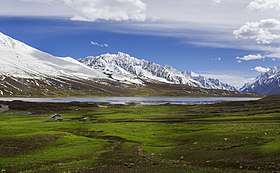Shandur Pass
Shandur Pass (Urdu: شندور) connects Ghizer District of Gilgit-Baltistan and Chitral District of Khyber Pakhtunkhwa. It is often called 'Roof of the World'. Shandur top is a flat plateau and can be crossed between late April and early November. The grade is very gradual, and the area is crossed by plentiful small streams during summer.
| Shandur Pass Template:Lang- urdu | |
|---|---|
 Shandur pass | |
| Elevation | 3,700 m (12,139 ft) |
| Traversed by | Gilgit–Shandur Road |
| Location | Pakistan[1] |
| Coordinates | 36°04′32″N 72°31′12″E |
 Location of Shandur Top | |
During the annual 'Shandur Polo Festival,' there are polo matches played in Shandur Polo Ground on Shandur Top, between the local teams of Gilgit-Baltistan and KPK. Approximately seven matches are played in the three days of the festival usually held on July 7th to 9th every year. The final match is played on July 9th between Teams A of Gilgit and Chitral.
History
In 1935 UK Administrator for Evelyn Hey Cobb ordered Niat Qabool Hayat Kakakhel nambardar of Ghizer to make a huge polo ground in Shandur. The polo ground was named "Mas Junali", because in the Khowar language ‘mas’ is the word for ‘moon’ and ‘junali’ is the word for ‘pologround’, and Cobb was fond of playing polo in the moonlight.[2] Cobb was impressed by Kakakhail's resourcefulness and efficiency and wished to reward him for his service, but Kakakhail refused to accept any reward for his work. Instead, for the common benefit, Kakakhail asked Cobb to bring trout to stock the local streams. Cobb ordered live trout from England and dropped them into the River Ghizer.[3] Due to this little service, Directorate of Fisheries had been established and hundreds of people got employed. Now the weight of those fishes in Hundarap Lake cross 24 kg and in Baha Lake Khukush Nallah, their weight crossed 40 kg.
So Mas Junali became a source of relation between the people of Chitral District and Ghizer District. The Shandur Polo Festival opens a door step to the people of the world to enjoy their selves. Many of the people from entire world come here to watch polo match played between Chitral and Ghizer.[4] At first it was a training game for cavalry units for the King's Guards or other Elite troops. To the warlike tribesmen who played polo with as many as 100 players to a side, it was a miniature battle. It became a Persian national game in the 6th century AD. From Persia, the game spread to Arabia, then to Tibet, China and Japan. In China, in the year 910, death of a favourite relative in a game prompted Emperor Apaochi to order beheading of all players.
Ali Sher Khan Anchan Maqpoun used to play Polo at Shandoor when Chitral was part of Maqpoun empire.[5] Historically, polo being the king of games was played between small kingdoms, villages and rival groups of Gilgit Agency. From 1936 onwards polo tournaments were held annually at Shandur at the patronage of the British. The three-day Shandur Polo Festival has developed steadily in recent years into the massive celebration of mountain polo that it is today.
References
- Shandur. Archived from the original on 2017-09-10. Retrieved 2017-08-30.
- http://www.shandur.chitralstudio.com/history/%5B%5D
- According to another source, it was Major B.H. Cobb, the political agent in Gilgit who introduced the brown trout into the Lotkoh River in 1945. They were placed at Parabik, nine miles from Garam Chashma, and their continued presence was confirmed the following year. Earlier experiments with trout introduction in 1931 and 1935 had failed. Naveed, Shan Ahmad (1973). "Trout in North-West Frontier Province". The Pakistan Journal of Forestry. 23: 343–353, page 344.
- Polo is an equestrian sport with its origin embedded in Central Asia dating back to 6th century BC
- Shandoor, Polo Ground. "Shandoor World Highest Polo Ground". www.skardu.pk. Skardu.pk. Archived from the original on 24 November 2016. Retrieved 23 November 2016.
https://www.chitraltoday.net/2019/05/31/know-some-basics-about-shandur-festival/
Books
- The Gilgit Game by John Keay (1985) ISBN 0-19-577466-3
- The Kafirs of the Hindukush (1896) Sir George Scott Robertson.
- To the Frontier (1984) Geoffrey Moorehouse, pp. 267–270. Hodder and Stoughton Ltd., Great Britain. Reprint: Sceptre edition 1988. ISBN 0-340-41725-0
- Shandur, Durand's Boundary Line Violation" (2014) by Rai Sarfaraz Shah, Ex-MNA LC Gilgit-Baltistan
External links
- https://web.archive.org/web/20180125163406/http://www.visitgilgitbaltistan.gov.pk/
- https://web.archive.org/web/20100831072645/http://gilgitbaltistan.gov.pk/
- http://www.shandur.chitralstudio.com/history/%5B%5D